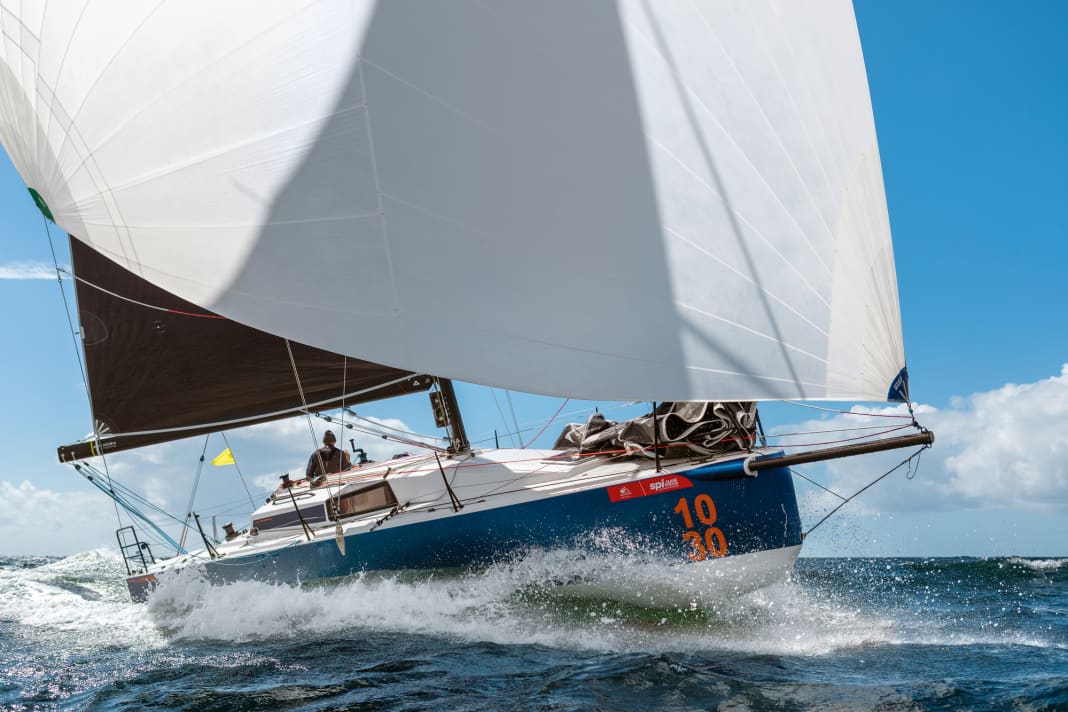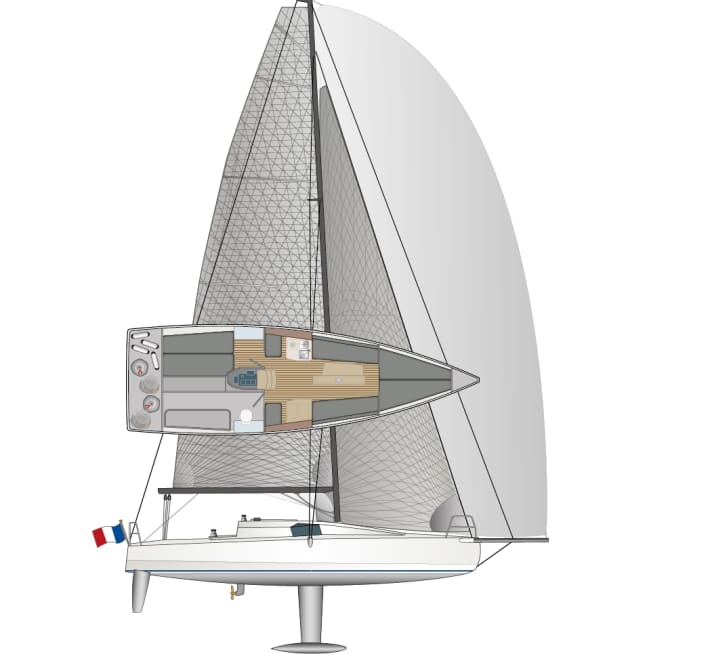





Jean-Pierre Kelbert (JPK) has realised the JPK 10.30 in his production facility in Brittany, France, as a further development of the equally successful JPK 10.80. The concept remains essentially the same: lots of performance, uncompromising optimisation of measurement, hardly any cruising.
Since its introduction, the JPK 10.30 has been winning races such as the Rolex Fastnet Race. Originally intended for regattas under the IRC remuneration system, crews have also won under ORC, for example at the 2022 World Championship, where three JPK 10.30s finished in the top three places in their group. Shipyard boss Jean-Pierre Kelbert (JPK for short) single-handedly steered his latest racer to victory in the 2019 Fastnet Race. So Kelbert not only knows how to sail regatta boats fast, but also how to build them.
The performance cruiser was also planned for the Olympics
Originally, JPK had also applied for the new Olympic discipline Mixed Offshore for the 2024 Games in Marseille with the 10.30. However, as a measurement-optimised IRC boat with a wide range of extras in terms of sails and equipment, the JPK 10.30 was not really suitable for the Olympic programme. For this reason, shipyard boss Kelbert and his in-house designer Jacques Valer revisited the concept and created an Olympic version. In this version, the ship was to have a 300-kilogram lighter T-keel with more draught and a lead bomb instead of the fin keel. The mainsail was to be slightly flared at the top and the mast could be trimmed with double aft stays. In addition, this version was to be a genuine one-design with only a few options - one of the most important requirements for an Olympic boat class. However, the IOC ultimately decided against the new Olympic offshore discipline in favour of a second kitesurfing discipline, rendering JPK's Olympic plans obsolete, as was the case with other applicants.
Difficult conditions when testing the JPK 10.30
YACHT was able to test build number 1, the standard boat, in 2020. There are those days when a YACHT test literally falls through. During our visit to the exciting boat of all places, the otherwise wind-safe sailing area off Lorient offered almost hopeless conditions with constant rain and a lull. Photos from better days therefore have to be used to illustrate the article. Unfortunately, the testers have not yet been able to sail the JPK 10.30 again in stronger winds.




Nevertheless, a weak breeze can build up in a few light moments during the test - just enough to give an impression of the sailing characteristics. And these are remarkable: even in just 5 knots of wind, the JPK 10.30 marches along at a speed of 4.4 knots at an angle of 40 degrees to the true wind and 29 degrees to the apparent wind. It is amazing how quickly this performance cruiser starts up and how easily it can be steered at the tiller.
The 10.30 has also arrived in the Baltic Sea region since its launch and has proven its enormous potential in many single-handed and double-handed regattas such as the Baltic 500 or Silverrudder - with top placings as well as strong sailing characteristics. For a boat optimised according to IRC, it starts planing early and can consistently log speeds of around 14 or 15 knots in 5 to 6 force winds, with a little wave support it can even reach over 22 knots at its peak.
The JPK 10.30 has high-quality basic equipment
As a multiple winner of the Transquadra single-handed and double-handed transatlantic regatta, Jean-Pierre Kelbert knows exactly how an efficient deck layout should be designed and where fittings, winches and clamps should be optimally positioned. The shipyard also makes no compromises when it comes to the quality of the basic equipment. All of the add-on parts come from the higher ranges; sheets, lines and all halyards are made of Dyneema material and are tapered and spliced wherever possible. This is the standard from the shipyard.
An aluminium mast is offered as standard for the 10.30, but the optional carbon fibre mast is ordered almost exclusively. The boat can also be equipped with water ballast tanks for regattas in single-handed or double-handed mode. The tanks, which are permanently laminated into the aft hull, each hold 300 litres of sea water and are filled and emptied via a so-called snorkel, a rotating plastic tube with an opening on one side, which is ejected downwards through the hull. Filling is quick at a good speed, about 100 seconds, emptying takes a little longer. The two tanks are connected to each other via arm-thick hoses. Shortly before tacking and jibing, the water ballast is transferred to the other side with the help of gravity; the more the boat heels, the faster the process. The shut-off valves required for this are operated from the cockpit.
The performance cruiser is less suitable for touring
If water ballast tanks are installed, as on the test boat, there is no double cabin on the port side aft, as provided on the standard boat. Instead, tubular bunks provide additional sleeping accommodation. In this case, however, the already very minimalist design of the toilet area with pump toilet and washbasin has to give way; regatta sailors will, however, be able to cope with this.
The saloon is dominated on both sides by the two strikingly large work surfaces of the navigation and galley. Between these areas and the cabin bulkhead, the shipyard has installed a watertight, upholstered reclining seat on each side. Here, single-handed sailors can relax, cook or navigate well protected and close to the cockpit on long journeys.
The JPK 10.30 is a technically sophisticated and demanding racer. Touring and family sailors will hardly be happy with it, but ambitious regatta sailors will be all the happier.
This article first appeared in YACHT 6/2020 and has been revised for this online version.

Technical data
- Designer Jacques Valer
- CE design category A
- Hull length 10.34 m
- Width 3.24 m
- Draught/alternative 1.96/2.30 m
- Weight 3.6 tonnes
- Ballast/proportion 1.5 t/42 %
- Mainsail 34.0 m2
- Furling genoa (106 %) 26.0 m²
- Engine (Volvo P.) 13 kW/18 hp
Hull and deck construction
GRP sandwich with foam core and vinyl ester resin, built with vacuum infusion. Main bulkheads made of plywood. Keel in the lower part made of lead
Price
Base price ex shipyard 141,500 euros (without sails, without electronics)
Shipyard and distribution
JPK Composites, 56260 Larmor-Plage (France); www.jpk.fr
YACHT rating
The powerful performance boat from JPK in France has already delivered an impressive performance record as an IRC racer.
Design and concept
- + Uncompromising alignment
- + Olympic version in preparation
- + Competitive base price
Sailing performance and trim
- + Strong performance even in light winds
- + One-handed and two-handed suitability
- - Complicated trimming devices
Living and finishing quality
- + Consistent lightweight construction
- - Minimal comfort for touring
Equipment and technology
- + Best equipment on deck
- + Water ballast tanks feasible
- - Hardly any storage space on and below deck

